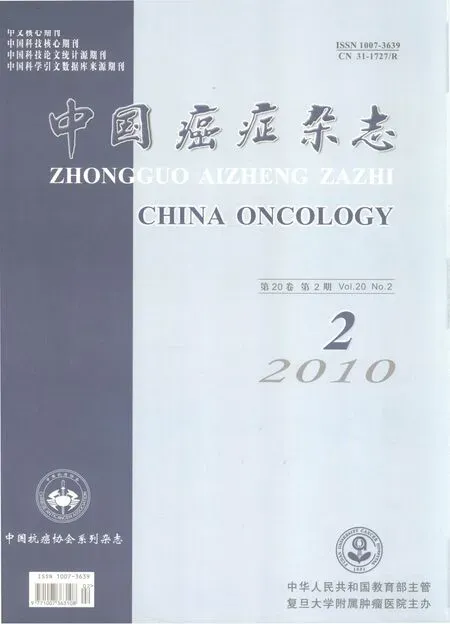紫杉醇腹腔灌注治疗胃癌恶性腹腔积液6例报道
杨晓燕 朱玉芬 邹海萍 郭显智 谢园园 印季良 董胜翔
1.上海市徐汇区中心医院肿瘤科,上海 200031;2.上海市复旦大学附属肿瘤医院化疗科,复旦大学上海医学院肿瘤学系,上海 200032
胃癌通常在进展期才得以诊断,韩国的1项对2 328例术后胃癌患者复发率调查的研究表明,约有45.9%的患者在术后8~21个月内发生腹膜转移[1]。较静脉化疗而言,腹腔内化疗对胃癌术后发生腹膜转移具有良好的局部抗癌治疗效果及腹水控制率,且局部药物浓度高,药物在腹腔内代谢缓慢、全身不良反应小,能显著提高腹腔转移肿瘤患者的生活质量。在日本腹腔内化疗已成为术后胃癌治疗的一项常规项目[2-3]。既往胃癌腹膜转移腹腔内化疗药物多以5-FU及顺铂为主,己有临床小样本研究表明,腹腔内直接注射紫杉醇治疗对胃癌腹膜转移具有良好的预防及治疗作用[4]。本研究报道2007年9月—2009年11月间我院肿瘤科收治的6例合并腹膜转移的晚期胃癌腹腔内紫杉醇治疗的临床疗效,并作一初步探讨。
1 资料和方法
1.1 病例资料 6例晚期胃癌患者均系2007年9月—2009年11月在本院肿瘤科住院的患者,男性5例,女性1例,年龄40~65岁,其中印戒细胞癌2例,低分化腺癌3例,低分化腺癌合并部分黏液腺癌1例。KPS评分均≥60,入院B超、CT显示有大量腹腔积液,腹腔积液中均查及癌细胞,外周血常规、肝肾功能均正常。
1.2 治疗方法 全身化疗以EOF(表柔比星、奥沙利铂、5-FU)为主,表1中例1在以紫杉醇腹腔化疗前用EOF全身化疗4个周期;例2以5-FU 600 mg/m2,第1~5天,DDP 25 mg/m2,第1~3天,化疗2个周期,以后口服卡培他滨2 000 mg/m2,第1~14天,每3周重复,长期维持;例3 EOF方案化疗为3个周期,TCF方案(紫杉醇135 mg/m2,第1天,顺铂25 mg/m2,第1~3天,5-FU 2.5 g/m2,静脉泵持续静脉滴注,120 h)7个周期;例4 EOF方案化疗6个周期,以后口服卡培他滨2 000mg/m2,第1~14天,每3周重复,长期维持;例5既往无全身化疗史;例6 EOF方案化疗7个周期,以后口服卡培他滨2 000mg/m2,第1~14天,每3周重复,长期维持。腹腔内治疗方案为采用腹腔闭式引流术在2~3日逐步引流尽癌性腹腔积液,在腹腔化疗前12、6 h分别口服地塞米松片20 mg,0.5 h前肌注异丙嗪25 mg,静脉推注甲氰咪胍0.3 g,托烷司琼5 mg预防呕吐,紫杉醇按60 mg/m2加入1 500~2 000 mL 0.9%氯化钠溶液中腹腔内给药,嘱患者给药1 h内变换体位以使药物在腹腔内分布均匀,用药期间密切观察生命体征。
1.3 疗效及毒性判定标准 恶性腹腔积液经化疗后腹水完全消失并维持4周以上为CR,腹腔积液减少1/2以上为PR,其余为NR(无反应),按照WHO标准判断不良反应。
2 结 果
5例患者(男性4例,女性1例)达到CR,另1例男性患者达到PR,腹腔积液消退时间0.5~10个月,总生存期2~10个月,4例Ⅰ~Ⅲ度腹胀、腹痛,4例患者Ⅰ度白细胞下降,3例Ⅰ度脱发,1例Ⅰ度肝功能损害(既往有乙型肝炎病史)。
3 讨 论
胃癌的腹腔内扩散是最常见的转移途径,早期诊断困难且易导致许多严重的并发症,诸如肠梗阻、恶性腹腔积液、肾积水等[5]。迄今为止,尚无有效控制恶性腹腔积液,提高生活质量的治疗方案。多个Ⅰ期及Ⅱ期临床试验表明,单用紫杉醇或多西他赛,或联合使用5-FU、顺铂、卡铂、UFT、S-I和依立替康,对进展期胃癌及晚期胃癌具有良好的缓解率,能明显提高患者的生活质量。腹腔内注射紫杉醇治疗恶性腹腔积液已在卵巢癌中广泛应用[6]。Shimoyama等[7]报道1例62岁合并大量腹腔积液的晚期胃癌女性患者以70 mg/m2每周腹腔内方案给药,连用3周后休息1周,腹水迅速消退,腹痛明显缓解,经随访3年仍然存活。1项Ⅱ期临床试验[8]表明,21例晚期胃癌患者每周静脉内注射紫杉醇50 mg/m2,腹腔内注射20 mg/m2,约62%患者腹水消退,1年生存率约为78%。Kodera等[4]以60 mg/m2每周腹腔内给药,采用连用3周休息1周的方案并至少持续2个周期治疗4例胃癌腹水患者,并在给药后0、3、24 h测定腹腔积液中紫杉醇浓度,发现给药后3 h腹腔注射峰值/血浆>2 000,半衰期17.4~65.3 h,2例患者腹水完全消退。Kobayashi等[9]的研究表明,2例晚期胃癌腹腔转移伴腹腔积液,静脉注射紫杉醇60~80 mg/m2即刻能达到血浆峰值,但在24 h可快速跌至85 ng/mL,但腹腔内药物浓度逐渐升高并达到血浆水平且维持72 h以上,2例病例腹腔积液经2个疗程治疗后迅速消退。

表1 6例晚期胃癌患者治疗结果Tab.1 The therapy result of six late-stage gastric cancer patients
至今为止,紫杉醇治疗胃癌恶性腹腔积液的报道仅见于散在个例或小样本的临床研究[10-11]。但均显示了良好的疗效及较长的生存时间。我们的小样本(6例)紫杉醇治疗胃癌腹水的临床研究显示5例(83%)患者出现完全缓解,随访至今,总生存期为2~10个月。有文献报道伴转移进展期胃癌中位生存期仅3~5个月,我们的临床研究表明,全身化疗辅以腹腔内化疗可以延长晚期胃癌患者的总生存期。3周紫杉醇方案治疗进展期胃癌的临床研究表明治疗反应率可高达23.4%,中位生存期达303 d[12]。紫杉醇治疗胃癌有其独一无二的特性,与5-FU无交叉抗药性,对分化差的胃癌活性好,静脉用药易于从血中扩散进入腹腔,相对较低的胃肠毒性发生率[13]。紫杉醇由于其大分子结构及高相对分子质量,在人体腹腔中,尤其是恶性腹水中有与其结合的高亲力蛋白,因而易潴留于腹腔中而不易清除[14];另外,有研究表明紫杉醇210 mg/m23周方案是AUC依赖的,较少产生不良反应[15];几个临床Ⅱ期试验亦表明,单用紫杉醇或联合用卡培他滨的1周或3周方案可以治疗5-FU和顺铂治疗失败的胃癌[16-19]。紫杉醇有效治疗胃癌的机制在于其促进癌细胞微丝微管不可逆聚合,与剂量依赖无关,它能诱导胃癌细胞凋亡,诱导TNF-α产生并增加放射治疗的敏感性[20]。本临床研究中1例患者经紫杉醇治疗后腹水仅达到部分缓解,可能与微丝微管基因突变、细胞膜磷酸化糖蛋白表达,以及药物泵出效应有关。
6例紫杉醇治疗胃癌恶性腹水的患者治疗中最常出现的不良反应依次为胃肠道反应(4例),白细胞减少(4例),脱发(3例),与文献报道[20]相符,经对症处理后好转。
紫杉醇腹腔内治疗进展期胃癌的临床研究尚少,仅有几个小样本的临床研究,初步已显示其治疗癌性腹水的良好疗效,但尚缺乏临床大样本的,或与5-FU、顺铂作为对照的研究,需进一步的临床探索。
[1] Yoo CH, Noh SH, Shin DW, et al. Recurrence following curative resection for gastric carcinoma[J]. Br J Surg, 2000,87(2): 236-242.
[2] Yonemura Y, Bandou E, Kinoshita K, et al. Effective therapy for peritoneal dissemination in gastric cancer[J]. Surg Oncol Clin N Am, 2003, 12(3): 635-648.
[3] Wenzel LB, Huang HQ, Armstrong DK, et al. Healthrelated quality of life during and after intraperitoneal versus intravenous chemotherapy for optimally debulked ovarian cancer: a Gynecologic Oncology Group Study[J]. J Clin Oncol, 2007, 25(4): 437-443.
[4] Kodera Y, Ito Y, Ito S, et al. Intraperitoneal paclitaxel:a possible impact of regional delivery for prevention of peritoneal carcinomatosis in patients with gastric carcinoma[J]. Hepatogastroenterology, 2007, 54(75): 960-963.
[5] Watanabe T, Hirono H, Hasegawa K, et al. Advanced gastric cancer patient with peritonitis carcinomatosa successfully treated with a combination therapy of paclitaxel and TS-1, but relapsed with multiple bone metastasis and died from rapidly progressive meningitis carcinomatosa--advanced gastric cancer with metachronous peritonitis carcinomatosa and meningitis carcinomatosa[J]. Intern Med, 2009, 48(3):151-156.
[6] Armstrong DK, Bundy B, Wenzel L, et al. Intraperitoneal cisplatin and paclitaxel in ovarian cancer[J]. N Engl J Med,2006, 354(1): 34-43.
[7] Shimoyama S, Kaminishi M. A three-year survivor case of gastric cancer with peritoneal dissemination--an outpatient with second-line weekly paclitaxel[J]. Gan To Kagaku Ryoho, 2008, 35(6): 1003-1007.
[8] Ishigami H, Kitayama J, Kaisaki S,et al. Phase Ⅱ study of weekly intravenous and intraperitoneal paclitaxel combined with S-1 for advanced gastric cancer with peritoneal metastasis[J]. Ann Oncol, 2010, 21(1): 67-70.
[9] Kobayashi M, Sakamoto J, Namikawa T, et al. Pharmacokinetic study of paclitaxel in malignant ascites from advanced gastric cancer patients[J]. World J Gastroenterol, 2006, 12(9):1412-1415.
[10] Xu RH, Teng KY. Progress in chemotherapy for advanced gastric cancer[J]. Chin J Cancer, 2009, 28(10): 1108-1113.
[11] Sun Q, Liu C, Zhong H, et al. Multi-center phase Ⅱ trial of weekly paclitaxel plus cisplatin combination chemotherapy in patients with advanced gastric and gastro-esophageal cancer[J]. Jpn J Clin Oncol, 2009, 39(4): 237-243.
[12] Emi Y, Yamamoto M, Takahashi I,et al. Phase Ⅱ study of weekly paclitaxel by one-hour infusion for advanced gastric cancer[J]. Surg Today, 2008, 38(11): 1013-1020.
[13] Tsuburaya A, Sakamoto J, Morita S, et al. A randomized phaseⅢ trial of post-operative adjuvant oral fluoropyrimidine versus sequential paclitaxel/oral fluoropyrimidine, and UFT versus S1 for T3/T4 gastric carcinoma: the Stomach Cancer Adjuvant Multi-institutional Trial Group (Samit) Trial[J]. Jpn J Clin Oncol, 2005, 35(11): 672-675.
[14] Tsai M, Lu Z, Wang J, et al. Effects of carrier on disposition and antitumor activity of intraperitoneal Paclitaxel[J].Pharm Res, 2007, 24(9): 1691-1701.
[15] Yamada T, Tanaka N, Furukawa K, et al. Antitumor effect of paclitaxel for gastric cancer is AUC dependent[J]. Gan To Kagaku Ryoho, 2008, 35(2): 251-253.
[16] Bang YJ, Kang WK, Kang YK, et al. Docetaxel 75 mg/m2is active and well tolerated in patients with metastatic or recurrent gastric cancer: a phase Ⅱ trial[J]. Jpn J Clin Oncol, 2002, 32(7): 248-254.
[17] Yoshikawa T, Tsuburaya A, Hirabayashi N, et al. A phase Ⅰstudy of palliative chemoradiation therapy with paclitaxel and cisplatin for local symptoms due to an unresectable primary advanced or locally recurrent gastric adenocarcinoma[J].Cancer Chemother Pharmacol, 2009, 64(6): 1071-1077.
[18] Baize N, Abakar-Mahamat A, Mounier N, et al. Phase Ⅱstudy of paclitaxel combined with capecitabine as secondline treatment for advanced gastric carcinoma after failure of cisplatin-based regimens[J]. Cancer Chemother Pharmacol, 2009, 64(3): 549-555.
[19] Cho H, Tsuburaya A, Sakamoto J, et al. A randomized phaseⅡ trial of preoperative exercise to reduce operative risk in gastric cancer patients with metabolic syndrome: adjuvant exercise for general elective surgery (AEGES) study group[J]. Jpn J Clin Oncol, 2008, 38(1): 71-73.
[20] Sakamoto J, Matsui T, Kodera Y. Paclitaxel chemotherapy for the treatment of gastric cancer[J]. Gastric Cancer, 2009,12(2): 69-78.

